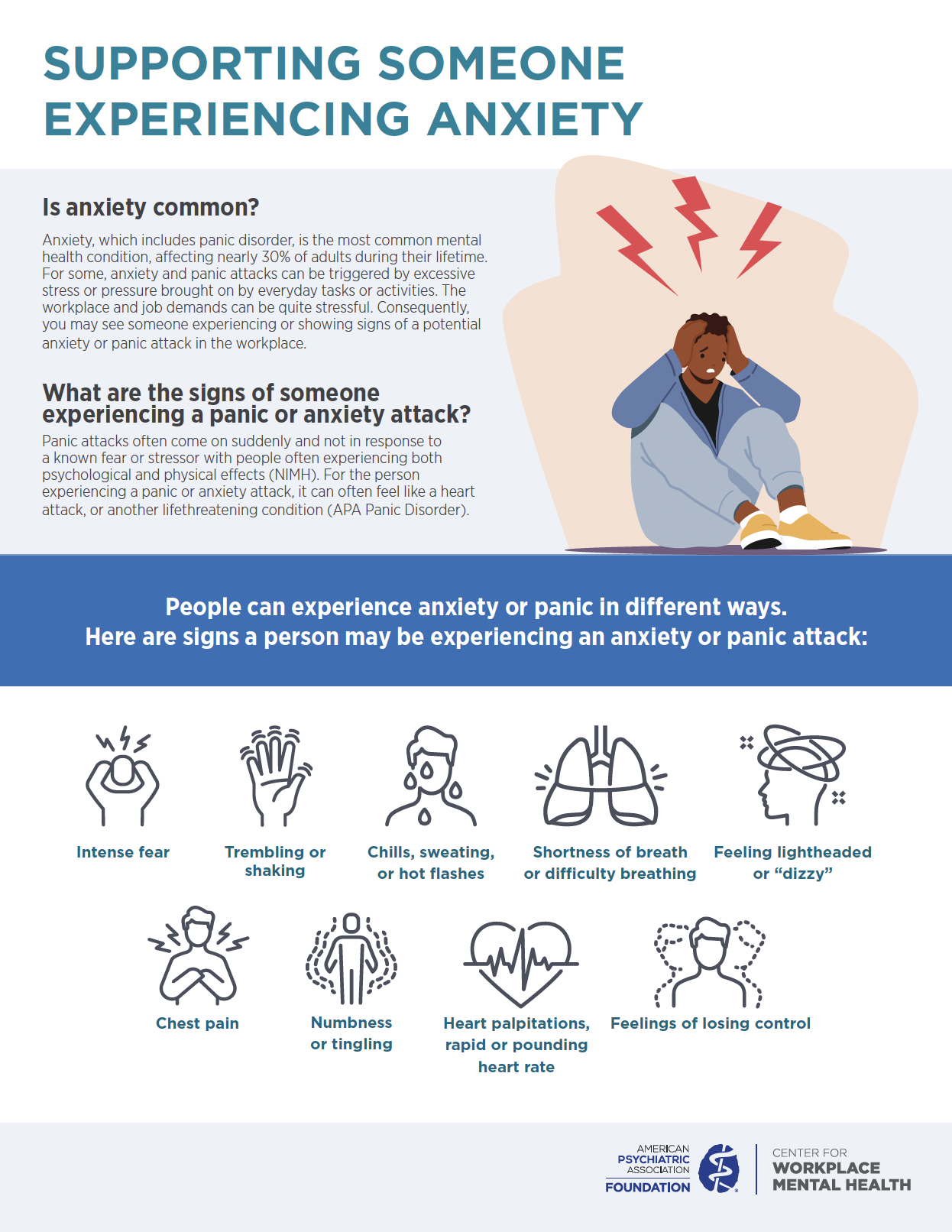
Is anxiety common?
Anxiety, which includes panic disorder, is the most common mental health condition, affecting nearly 30% of adults during their lifetime. For some, anxiety and panic attacks can be triggered by excessive stress or pressure brought on by everyday tasks or activities. The workplace and job demands can be quite stressful. Consequently, you may see someone experiencing or showing signs of a potential anxiety or panic attack in the workplace.
What are the signs of someone experiencing a panic or anxiety attack?
Panic attacks often come on suddenly and not in response to a known fear or stressor with people often experiencing both psychological and physical effects (NIMH). For the person experiencing a panic or anxiety attack, it can often feel like a heart attack, or another life-threatening condition (APA Panic Disorder).
People can experience anxiety or panic in different ways. Here are signs a person may be experiencing an anxiety or panic attack:
- Intense fear
- Trembling or shaking
- Chills, sweating, or hot flashes
- Shortness of breath or difficulty breathing
- Feeling lightheaded or "dizzy"
- Chest pain
- Numbness or tingling
- Heart palpitations, rapid or pounding heart rate
- Feelings of losing control
How do you support someone experiencing panic or anxiety?
The most important thing you can do to support a person who seems highly anxious is to remain calm, even if you are feeling uneasy. If at any point you feel overwhelmed by the situation, reach out to another person to provide help.
Here are ways to support a person experiencing a potential panic or anxiety attack:
- Calmly reassure the person that they are safe and let them know that you will stay with them to make sure they are ok.
- Provide words of encouragement like, "you’re doing great" and "you're going to get through this."
- Encourage them to focus on taking deep breaths, breathing in through their nose and out through their mouth.
- Reassure them that feeling anxious is more common than they think that many of us feel that way from time to time.
- Ask how you can best support them. If the person responds that they don’t need support, or do not want you to stay with them, let them know that you will stay close by. If you will be out of their sightline, let them know where you’ll be should they decide they need help.
- When the panic or anxious feelings have passed, ask how you can help them get connected with services and supports. Consider asking if you can help them get connected with the Employee Assistance Program (EAP), or other mental health benefits and services.
- If the panic attack does not subside, ask the person if they are comfortable walking to HR or another designated person within the organization or would prefer that you call for assistance.
You can make a positive difference for someone experiencing anxiety or feeling panicked by providing reassurance, showing that you care, and offering to connect the person with additional support, if needed.
References
1American Psychiatric Association. What are Anxiety Disorders? https://psychiatry.org/patients-families/ anxiety-disorders/what-are-anxiety-disorders2National Institute of Mental Health (NIMH). Panic Disorder. https://www.nimh.nih.gov/health/statistics/panic-disorder#:~:text=Panic%20Disorder%20is%20an%20anxiety,%2C%20dizziness%2C%20or%20abdominal%20 distress
3PsychCentral. How to Help Someone Having a Panic Attack. https://psychcentral.com/anxiety/how-to-help-someone-having-a-panic-attack#name-it
